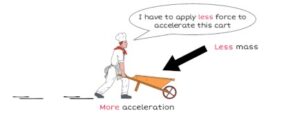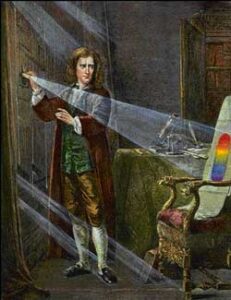Early Days
- Isaac Newton was born on 25 December 1642 in Lincolnshire, England and lived till 31 March 1727.
- He was an eminent Mathematician, Physicist, Astronomer, Theologian, and Author.
- Newton got his early education at The King's School, Grantham, where he learnt Latin, Ancient Greek and fundamentals of mathematics.
- He started studying at Trinity College, Cambridge, on the recommendation of his uncle Reverent William Ayscough in June 1661.
- He was awarded scholarship in pursuing his Masters Degree.
- His Learnings were based on the principles of Aristotle and his ideal modern philosophers were Descartes and admired work of Galileo and Thomas Street for their contribution towards astronomy. He was impressed from the Learning of Kepler's work.
- With the work of Newton in Physics which became the most admired publication "Philosophiae Naturalis Principia Mathematica (Mathematical Principles of Natural Philosophy)" in 1687 earned him the title of Sir Issac Newton awarded by Queen Anne of England in 1705.
Newton's Research in Theoretical Physics
Newton’s Magnum Opus
The Principia - 1687 A.D
“Truth is ever to be found in the simplicity, and not in the multiplicity and confusion of things.”
Sir Isaac Newton contributed to many branches of human thought, among which physics and mathematics were the fields in which he contributed substantially.
The greatest of Newton’s discoveries came when he experienced pristine solitude, in which he could meditate on his vague ideas and assimilate them together into a logically coherent whole.
The principle that guided Newton’s discoveries was simplicity.
The Laws of Motion - 1666 A.D
First Law of Motion (Law of Inertia)
"An object will continue moving (or staying still) unless acted upon by an external force."
First Law of Motion in Real Life:
Second Law of Motion (Force Law):
"Force = Mass x Acceleration"
Second Law of Motion in Real Life:
The force acting on a body is defined as the rate of change of its linear momentum, with time.
Third Law of Motion (Action-Reaction Law):
"When one body exerts a force on a second body, the second body simultaneously exerts a force equal in magnitude and opposite in direction to that of the first body."
Third Law of Motion in Real Life:
Every action has an equal and opposite reaction.
Law of Gravitation - 1687 A.D
"Every particle of matter attracts every other particle with a force along the straight line joining them and is directly proportional to their masses, while inversely proportional to the square of the distance between them."
Newton’s law of gravitation defines the universal force of gravity, whose implications can be studied in the mechanical framework that he created through the laws of motion.
Discoveries in Optics
Inquiry into the nature of light
Opticks
Refraction and Diffraction of Light
Newton focused on unfolding the nature of light and its properties using prisms and lenses. Thus making unparalleled contribution in the field of Optics.
1. Research on Light and Optics
1.1 - He discovered white light to be composed of component color wavelengths.
1.2 - He demonstrated this with the use of a prism which dispersed a beam of white light into wavelengths of different hues.
1.3 - It’s the same effect which leads to the formation of rainbows in the sky.
2. Research on Color and Light
2.1 - His experiments revealed that color arose from reflection and transmission of light and primarily from selective absorption of light by materials.
2.2 - Different angles at which individual wavelengths of light dispersed from a prism, he concluded that color arises from a fundamental property of light itself, though revealed only through interaction with matter.
2.3 - Most colors are created from overlapping of certain color components. He believed that human perception of color is essentially a mental phenomenon or subjective experience.
3. Dispersion and Aberration of Light
3.1 - Newton predicted the dispersion and aberration of light in telescopes and suggested changes to correct the same. He promoted the concept of a universal ether through which light propagates - Though this theory was countered wrong by experimental tests of the Special Theory of Relativity.
3.2 - Newton showed white light to be made of component colors.
Newton's other Findings on Light
I. Newton found that light is made up of corpuscles, which was later proved wrong by Huygens’ Wave Theory of light.
II. Newton's idea was revived by support of Einstein's theory of light to be made of photons which are energy corpuscles.
Newton’s Law of Cooling
dT/dt = – K (T – Ts)
where,
T is temperature of the body,
K is a constant,
dT/dt is a time derivative representing change of temperature
Ts is the temperature of surroundings. (The derivative is ‘negative’ as the body is cooling).
Newton's Law of Cooling states that the rate of cooling in a body is directly proportional to temperature difference between the body and its surroundings.
Newton's Law of Cooling in Real Life
Newton’s Discoveries in Mathematics
Binomial Theorem
His first original contribution to mathematics was the advancement of binomial theorem. Through the usage of algebra of finite quantities in an infinite series, he included negative and fractional exponents in the binomial theorem.
Calculus
- Newton came up with his greatest breakthroughs in physics and mathematics.
- Through invention of Infinitesimal Calculus, Newton provided a mathematical framework which enabled the study of continuous changes. He called it the Science of Fluxions.
- The invention of calculus ranks right up there with invention of fire or the building of the first steam engine. His approach to calculus was geometrical, in contrast to Leibniz, who was inclined more towards the analytical side.
Newton-Raphson Method
- In his book, "De analysi per aequationes numero terminorum infinitas (Latin for On analysis by infinite series)", published in 1771, Newton contributed to numerical analysis in the form of Newton-Raphson method.
- Newton described this iterative method of approximation to calculate roots of real-valued functions. The method is described by the following formula.
xn+1 = xn – f(xn) / f'(xn)










